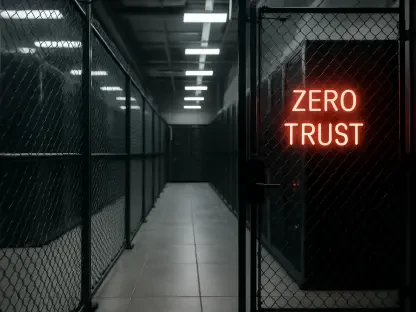In today’s digital battleground, a staggering 80% of cyberattacks target vulnerabilities within web browsers, exploiting the very tools businesses rely on daily. Picture a multinational corporation, its employees navigating countless websites, unaware that malware is assembling silently within their browsers, ready to strike at critical data. This alarming reality underscores a seismic shift in cyber threats, where traditional defenses are crumbling under the weight of sophisticated, browser-based attacks. As adversaries weaponize encrypted traffic and AI-driven tactics, the urgency for a new cybersecurity paradigm has never been clearer.
The significance of this challenge cannot be overstated. With sensitive data flowing through unstructured channels and AI tools amplifying exposure, the old perimeter-based security model is obsolete. Enter Prisma SASE 4.0, a groundbreaking solution from Palo Alto Networks that promises to revolutionize defense mechanisms. This feature dives into how this platform counters the evolving threat landscape, offering real-time protection and AI-powered precision to safeguard organizations from the inside out.
Why Browser-Based Threats Are the New Cyber Battleground
Cybercriminals have shifted their focus to browsers, recognizing them as the gateway to an organization’s most sensitive assets. Recent studies reveal that over 75% of malware infections now originate from web-based exploits, often bypassing outdated security tools. These attacks assemble malicious code directly within the browser environment, exploiting encrypted traffic that traditional firewalls can’t inspect.
This trend reflects a broader evolution in attack strategies, where adversaries leverage AI to craft highly targeted phishing schemes and credential theft operations. Unlike past threats that focused on network breaches, today’s dangers hide in plain sight, embedded in seemingly harmless web pages. The scale of this problem is evident in reports showing a 60% increase in browser-based attacks over the past two years alone.
The implications are dire for businesses unprepared for this shift. Without advanced protection, even a single compromised browser can lead to devastating data leaks or ransomware lockdowns. This growing menace sets the stage for innovative solutions that can adapt to threats in real time, addressing vulnerabilities where they emerge.
The Fall of Traditional Security: A Perimeter in Ruins
For decades, cybersecurity relied on a fortress mentality, with proxies and web application firewalls guarding a defined perimeter. However, as remote work and cloud adoption have surged, this model has disintegrated, leaving sensitive data exposed across countless digital touchpoints. The rise of unstructured content and AI-generated material further complicates the landscape, creating blind spots that legacy systems cannot monitor.
Consider the real-world impact: a mid-sized firm adopting AI tools for productivity unknowingly increases its attack surface, as adversaries exploit these platforms for data theft. Industry data indicates that 68% of organizations using such tools have reported security incidents tied to unmonitored channels. Traditional defenses, built for static environments, simply cannot keep pace with these dynamic risks.
This gap highlights a critical need for integrated, adaptive solutions. As cyber threats evolve faster than ever, clinging to outdated methods is akin to locking the front door while leaving the windows wide open. The demand for a modern approach, capable of securing data wherever it resides, has become non-negotiable.
Prisma SASE 4.0: Revolutionizing Cyber Defense
Prisma SASE 4.0 emerges as a transformative force, redefining how organizations combat modern cyber threats. Developed by Palo Alto Networks, this platform introduces cutting-edge features like real-time inspection of fully rendered web pages, catching malware that slips past legacy browsers. This capability alone thwarted a sophisticated phishing attack targeting a financial institution last quarter, preventing a potential multimillion-dollar loss.
Beyond web protection, the platform leverages AI-driven data security with over 140 machine learning classifiers, slashing false positives and pinpointing sensitive information across formats. Additionally, the Prisma Browser offers last-mile defense directly within the browser environment, while Private App Security automates protection for critical applications, dynamically updating policies. These tools address specific vulnerabilities, such as DNS exploitation, which affected 45% of enterprises in recent surveys.
Each component of this solution tackles a unique facet of the threat landscape, from encrypted traffic exploits to insider risks. By integrating these defenses into a single, cohesive framework, the platform ensures comprehensive coverage. This holistic approach marks a significant departure from the fragmented strategies of the past, setting a new benchmark for cybersecurity resilience.
Expert Voices: Endorsing a New Cybersecurity Standard
Industry leaders are sounding the alarm on the urgent need for advanced SASE solutions. A senior executive from Palo Alto Networks recently stated, “AI-powered threats are evolving at a pace that renders traditional tools obsolete; Prisma SASE 4.0 is built to neutralize these risks before they strike.” This perspective aligns with broader consensus, as analysts note a 50% uptick in demand for integrated security platforms over the past year.
Further validation comes from businesses grappling with browser vulnerabilities. A tech startup shared a sobering account of losing critical client data to a browser-based attack, only to recover after adopting next-gen solutions. Such anecdotes underscore the real-world stakes, where outdated defenses leave companies vulnerable to cascading failures.
These insights cement the platform’s role as a forward-thinking answer to an escalating crisis. Experts agree that embracing such innovations is no longer optional but a strategic imperative. Their endorsements lend weight to the argument that a new standard in cybersecurity is not just emerging—it’s already here.
Implementing Prisma SASE 4.0: Strategies for Organizational Success
Adopting a solution as powerful as Prisma SASE 4.0 requires a clear roadmap tailored to an organization’s unique needs. The first step involves a thorough assessment of current browser vulnerabilities, identifying weak points where threats are most likely to infiltrate. For many companies, this process revealed over 30% of their workforce using unsecured browsers, a gap easily exploited by attackers.
Next, prioritizing critical applications for Private App Security ensures that high-value assets receive immediate protection, while real-time threat detection capabilities are activated across all web interactions. Training staff on recognizing and reporting suspicious activity further strengthens this defense, embedding a culture of vigilance. Small businesses, in particular, can benefit from phased implementations, starting with core features before scaling up.
These actionable strategies empower organizations of all sizes to harness the platform’s full potential. By aligning deployment with specific risks and operational goals, companies can transform their cybersecurity posture. This proactive stance is essential in a landscape where threats evolve daily, demanding agility and precision in response.
Reflecting on a Cybersecurity Turning Point
Looking back, the journey toward robust cybersecurity revealed a stark truth: the old ways of defense had faltered against the ingenuity of modern threats. Prisma SASE 4.0 stood as a beacon of innovation, offering tools that not only countered browser-based attacks but also redefined how organizations protected their digital frontiers. Its impact was felt across industries, reshaping the conversation around data security.
As businesses moved forward, the next steps became clear—assess vulnerabilities with unflinching honesty, integrate advanced solutions with strategic intent, and foster a mindset of continuous adaptation. Exploring partnerships with cybersecurity experts could further amplify resilience, ensuring that defenses evolved in lockstep with emerging risks. This path, though challenging, promised a future where security was not just a reaction but a foundation.









